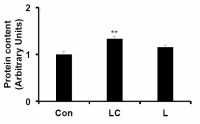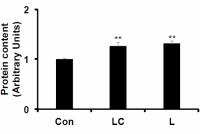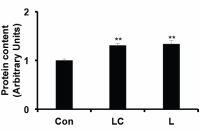Well one thing is for sure as an 400m sprinter I am all too familiar with Lacate and caffiene and do use both as supplements. But not necessarily for the reasons that a team of Japanese researchers used for, Some very interesting research but at some very large dosages.
A truly fascinating article the Japanese published in the Journal of Applied Physiology.
In-vitro study
The Japanese did in-vitro experiments with C2C12 muscle cells. They exposed the cells to 10 millimoles sodium lactate [L] or 10 millimoles plus 5 millimoles caffeine [LC].
The figures below show that the combined exposure to lactate and caffeine boosted the synthesis of the anabolic signal proteins MyoD [below left] and myogenin [below right].
 |
 |
 |
 |
The combination of lactate and caffeine also activated the anabolic signal molecules mTOR [above left] and S6K [above right].
Animal study
Interesting results, but muscle cells in a petri dish are, of course, not muscles in a living organism. That’s why the Japanese also performed an animal study, in which they got male rats to run for 20 minutes on a treadmill every other day for four weeks. The Japanese gave some of the rats lactate and caffeine as well.
The rats in the control group did not run and didn’t get a supplement either.
The rats that got supplements were given them daily. If you convert the dosages to human proportions you arrive at about 10-14 g sodium lactate and 400-600 mg caffeine a day. The supplements were administered orally to the rats.
At the end of the four weeks the rats that had been given lactic acid and caffeine had built up more muscles than the animals that had only done exercise.
The researchers found that the rats that had been given the supplement had more DNA in their muscles. That suggests that the muscles had attracted more stem cells, which they had then changed into muscle cells.
Mechanism
“Lactate-caffeine treatment increased satellite cell activity and anabolic signals in C2C12 cells, and low-intensity exercise with a mixed lactate and caffeine compound increased muscle mass, satellite cell activity and anabolic signals in vivo”, the researchers wrote in summary.
The Japanese don’t know exactly how the supplement does this, but they have a suspicion. “Calcium signals are candidate mediators of increases in satellite cell activity and anabolic signals”, they write.
“Lactate may activate calcium/calmodulin-activated serine-threonine phosphatases calcineurine and myogenin. Calcineurine dephosphorylates nuclear factor of activated T cell (NFAT). Calcineurine/NFAT is implicated in the regulation of satellite cell proliferation. Moreover, calcineurine/NFAT increases myogenic factor 5 (Myf5) expression, which is in the muscle regulatory factor family.”
“Caffeine is an inhibitor of phosphodiesterase, increasing intracellular cAMP and actually activating the protein kinase cascade driven by cAMP (including Akt) in this study.”
“Lactate and caffeine may complement one another to promote muscle anabolism and could effectively increase muscle mass by increasing satellite cell activity and anabolic signals.”
Conclusion
“We found for the first time that treatment of lactate-caffeine compound increases satellite cell activity and anabolic signals in C2C12 cells”, the Japanese researchers concluded. “Furthermore, low-intensity exercise with lactate-caffeine compound increases muscle mass, satellite cell activity, and anabolic signals.”
“These results suggest that administration of lactate-caffeine compound could effectively increase muscle mass concomitant with elevated myonuclei, even with low-intensity exercise, by means of activated satellite cells and anabolic signals in skeletal muscle. Therefore, study of lactate-caffeine compound should provide insight into the development of strategies against muscle wasting and loss of function associated with a wide range of neuromuscular diseases such as sarcopenia.”
Images used courtesy of Total Shape





